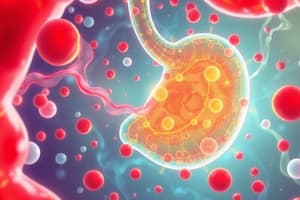Podcast
Questions and Answers
What are the mechanisms by which sodium bicarbonate acts as an antacid?
What are the mechanisms by which sodium bicarbonate acts as an antacid?
Sodium bicarbonate acts by neutralizing gastric acid, producing carbon dioxide as a by-product, which can lead to bloating and belching.
Explain the primary use of misoprostol and its contraindications.
Explain the primary use of misoprostol and its contraindications.
Misoprostol is used to decrease acid secretion and promote bicarbonate and mucous secretion; it is contraindicated in pregnancy due to the risk of stimulating uterine contractions.
Describe how bismuth compounds contribute to gastrointestinal health.
Describe how bismuth compounds contribute to gastrointestinal health.
Bismuth compounds coat erosions and ulcers, stimulate mucous and bicarbonate secretion, and have direct antimicrobial effects, including against H. pylori.
What are the consequences of using magnesium and aluminum hydroxide together?
What are the consequences of using magnesium and aluminum hydroxide together?
What risks are associated with sodium bicarbonate in patients with reduced renal function?
What risks are associated with sodium bicarbonate in patients with reduced renal function?
What is the primary mechanism of action of antacids in treating GERD?
What is the primary mechanism of action of antacids in treating GERD?
How do proton pump inhibitors (PPIs) like omeprazole affect the efficacy of clopidogrel?
How do proton pump inhibitors (PPIs) like omeprazole affect the efficacy of clopidogrel?
What are some common adverse effects associated with the use of proton pump inhibitors?
What are some common adverse effects associated with the use of proton pump inhibitors?
Discuss the mechanism by which histamine type 2 receptor antagonists reduce stomach acid secretion.
Discuss the mechanism by which histamine type 2 receptor antagonists reduce stomach acid secretion.
What notable adverse effects are associated with the use of cimetidine, compared to other H2 blockers?
What notable adverse effects are associated with the use of cimetidine, compared to other H2 blockers?
How do antacids stimulate prostaglandin production?
How do antacids stimulate prostaglandin production?
Explain the role of bismuth compounds in gastrointestinal treatment.
Explain the role of bismuth compounds in gastrointestinal treatment.
What is one consequence of the inhibition of calcium absorption by proton pump inhibitors?
What is one consequence of the inhibition of calcium absorption by proton pump inhibitors?
How do proton pump inhibitors (PPIs) relate to the treatment of PUD and GERD?
How do proton pump inhibitors (PPIs) relate to the treatment of PUD and GERD?
What is the importance of the prodrug nature of most proton pump inhibitors?
What is the importance of the prodrug nature of most proton pump inhibitors?
Describe a potential drug interaction involving PPIs and nutrients.
Describe a potential drug interaction involving PPIs and nutrients.
How do bismuth compounds contribute to the treatment of PUD?
How do bismuth compounds contribute to the treatment of PUD?
What are the implications of using promotility agents with PPIs?
What are the implications of using promotility agents with PPIs?
Explain the role of misoprostol in the management of PUD?
Explain the role of misoprostol in the management of PUD?
What impact do proton pump inhibitors have on the absorption of ketoconazole?
What impact do proton pump inhibitors have on the absorption of ketoconazole?
How is calcium absorption affected by long-term PPI use?
How is calcium absorption affected by long-term PPI use?
Flashcards
Sodium Bicarbonate as Antacid
Sodium Bicarbonate as Antacid
A fast-acting antacid producing CO2 as by-product, causing bloating and belching. Can cause metabolic alkalosis, especially in those with kidney problems.
Calcium Carbonate Antacid
Calcium Carbonate Antacid
Another antacid that produces CO2, but slower than sodium bicarbonate, also causing bloating and belching.
Magnesium/Aluminum Hydroxide Antacid
Magnesium/Aluminum Hydroxide Antacid
Antacid producing no CO2. Low risk of metabolic alkalosis. Often used in combination to balance side effects, like diarrhea and constipation.
Misoprostol Mechanism
Misoprostol Mechanism
Signup and view all the flashcards
Misoprostol Use Caution
Misoprostol Use Caution
Signup and view all the flashcards
Clopidogrel Drug Interaction
Clopidogrel Drug Interaction
Signup and view all the flashcards
PPI Toxicity
PPI Toxicity
Signup and view all the flashcards
H2 Receptor Antagonist MOA
H2 Receptor Antagonist MOA
Signup and view all the flashcards
H2 Receptor Antagonist Toxicity
H2 Receptor Antagonist Toxicity
Signup and view all the flashcards
Antacids Mechanism
Antacids Mechanism
Signup and view all the flashcards
Common Antacid Use
Common Antacid Use
Signup and view all the flashcards
Antacid Dose vs. Stomach Acid
Antacid Dose vs. Stomach Acid
Signup and view all the flashcards
Antacid Types
Antacid Types
Signup and view all the flashcards
Proton Pump Inhibitors (PPIs)
Proton Pump Inhibitors (PPIs)
Signup and view all the flashcards
MOA of PPIs
MOA of PPIs
Signup and view all the flashcards
PPI Prodrugs
PPI Prodrugs
Signup and view all the flashcards
PPI Pharmacokinetics (PK)
PPI Pharmacokinetics (PK)
Signup and view all the flashcards
PPI Metabolism
PPI Metabolism
Signup and view all the flashcards
PPI Vitamin B12 Interaction
PPI Vitamin B12 Interaction
Signup and view all the flashcards
PPI Drug Interactions
PPI Drug Interactions
Signup and view all the flashcards
PPI Long-Term Effects
PPI Long-Term Effects
Signup and view all the flashcards
Study Notes
PUD/GERD Pharmacology
- The topics covered include a review of acid secretion and the pharmacology of agents used to treat peptic ulcer disease (PUD)/gastroesophageal reflux disease (GERD), and dyspepsia.
- Recommended reading includes chapters 62 (sections 1-3) of "Basic and Clinical Pharmacology" (15th edition) and chapter 53 of "The Pharmacological Basis of Therapeutics" (14th edition).
Overview
- The presentation discusses a review of acid secretion.
- It also covers the pharmacology of agents used to treat PUD/GERD and dyspepsia.
Recommended Reading
- Recommended resources for further study include "Basic and Clinical Pharmacology, 15e" (Chapter 62, sections 1-3), and "The Pharmacological Basis of Therapeutics, 14e" (Chapter 53).
Video #1
- The video displays a diagram showcasing the various pathways and receptors involved in acid secretion within the stomach.
- It highlights factors such as cholinergic nerve stimulation, histamine, gastrin, prostaglandins (PGE2), and proton pump inhibitors impacting the parietal cells.
Video #2
- The second video describes the mechanism of action of proton pump inhibitors (PPIs).
- It emphasizes the covalent inhibition of the H+, K+ ATPase enzyme within the parietal cell, leading to reduced acid production.
- It also shows the accumulation of PPIs within the parietal cell at low pH (around 4).
- The diagram shows the crucial sulfenamide reaction with cysteine residues.
Proton Pump Inhibitors - MOA
- Proton pump inhibitors (PPIs) include omeprazole, esomeprazole, pantoprazole, and others.
- These drugs are structurally related to H2-receptor antagonists, but lack affinity for the H2 histamine receptor.
- They function by specifically and selectively inhibiting the gastric proton pump.
- Most PPIs are prodrugs, requiring activation after absorption.
- Various enteric-coated formulations are used to prevent the PPI from breaking down before reaching the target site.
Proton Pump Inhibitors - PK Notes
- Pharmacokinetic properties like pKa, bioavailability, half-life, maximum plasma concentration (Tmax), and dosing regimens are presented.
- Relevant data are tabulated to assist with quick reference and analysis.
- Drug-nutrient interactions with vitamin B12, iron, calcium, and magnesium are mentioned along with a potential impact on absorption.
- These drugs are primarily metabolized by CYP2C19 and 3A4, with minimal renal clearance.
- Their short plasma half-lives contrast with the extended duration of their effect due to reversible inhibition of the proton pump.
- Drug interactions with clopidogrel, an antiplatelet, are discussed. These interactions can potentially reduce clopidogrel's effectiveness and increase cardiovascular risk.
Proton Pump Inhibitors - Toxicity Notes
- Common adverse effects (ADRs) of PPIs are diarrhea and headache.
- Long-term use may be associated with kidney dysfunction, fractures, and infections; potential reasons include calcium absorption inhibition and altered gut flora.
Histamine type 2 receptor antagonists - MOA
- These drugs are competitive H2-receptor antagonists.
- The primary mechanism of action involves blockade of H2 receptors on parietal cells.
- They are highly selective for the H2-receptor, leading to fewer off-target effects.
- They are effective in inhibiting nocturnal acid secretion.
- However, they also inhibit all acid secretion.
Histamine type 2 receptor antagonists - MOA (Table)
- Clinical comparisons of different histamine type 2 receptor blockers, outlining their potency, dose required for 50% acid inhibition in 10 hours, and typical dosing for various conditions like acute ulcers, GERD, and stress-related bleeding.
- Common drugs like cimetidine, ranitidine, nizatidine, and famotidine are included, along with their approximate potency, the acid inhibitory dose required, and their usual dosages.
Histamine type 2 receptor antagonists - Toxicity
- Overall, adverse effects are minimal with these drugs.
- However, cimetidine, the first H2-blocker, has notable side effects, including androgen receptor antagonism, an increase in prolactin levels, and interference with estradiol metabolism.
- Cimetidine has an unusually high number of drug interactions due to its inhibition of specific drug-metabolizing enzymes (CYP 1A2, 2C9, 2D6, and 3A4).
Antacids
- Commonly used for intermittent or short-term GERD relief.
- Antacids act by neutralizing stomach acid through direct reaction with H+.
- Some antacids can stimulate prostaglandin production.
- Typical antacids contain 3-4 times the milliequivalents (mEq) of base salts needed to neutralize stomach acid.
Antacids - specific types
- Different antacid types (sodium bicarbonate, calcium carbonate, and magnesium/aluminum hydroxide) have differing properties.
- Sodium bicarbonate quickly produces carbon dioxide, which can lead to bloating and belching. It may also cause metabolic alkalosis, especially in people with compromised kidney function.
- Calcium carbonate also produces carbon dioxide, but the reaction is slower than with sodium bicarbonate.
- Magnesium/aluminum hydroxide, does not produce carbon dioxide as a byproduct, and has a lower risk of inducing metabolic alkalosis. This option may cause osmotic diarrhea, though, due to potential magnesium salts production.
Misoprostol
- Misoprostol is a methyl-PGE1 analog.
- It has a very short serum half-life.
- This drug decreases acid secretion, promotes bicarbonate and mucous secretion, and activates PGE2 receptors.
- Misoprostol can stimulate uterine contractions; thus, it is contraindicated during pregnancy and generally used with caution in women of childbearing age.
Bismuth Compounds
- Bismuth compounds can coat the esophagus and stomach lining, may stimulate prostaglandin production, increase mucus and bicarbonate secretion, decrease GI secretions, and have antimicrobial effects against H. pylori.
- Possible side effects include stool and tongue discoloration
Sucralfate
- Sucralfate is a complex of sucrose and aluminum hydroxide.
- It forms a viscous solution in water.
- It is thought to coat and protect areas of the GI tract that have a high negative charge, particularly those affected by ulcers.
Promotility Agents - Dopamine Receptor Antagonists
- Dopamine receptor antagonists (like metoclopramide and domperidone) inhibit cholinergic muscle stimulation, increase peristalsis, improve esophageal tone, and enhance gastric emptying.
- These agents can also act as antiemetics (preventing nausea and vomiting).
Promotility Agents - Dopamine Receptor Antagonists (Adverse Effects)
- Primarily CNS-related adverse effects, including restlessness, drowsiness, insomnia, anxiety, and agitation, are often more pronounced in older adults.
- Long-term use might increase the risk of tardive dyskinesia and other EPS (extrapyramidal symptoms) in some cases.
- Hyperprolactinemia (increased prolactin levels), galactorrhea, gynecomastia, and menstrual disturbances can also occur.
- Domperidone is less likely to cross the blood-brain barrier (BBB), and therefore generally has fewer central nervous system side effects.
Promotility Agents - Other
- Cisapride and prucalopride are 5-HT4 receptor agonists, generally promoting prokinetic activity.
- Cisapride was removed due to rare but serious cardiac arrhythmias.
- Alosetron is an 5-HT3 antagonist, used primarily as an antiemetic.
- Erythromycin is a macrolide antibiotic showing prokinetic activity by mimicking motilin.
Studying That Suits You
Use AI to generate personalized quizzes and flashcards to suit your learning preferences.



